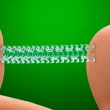In-stent restenosis (ISR) remains the main limitation in the percutaneous treatment of coronary artery disease, with a prevalence between 5% and 10% after implantation of latest-generation drug-eluting stents (DES). Therapeutic recommendations for it include the implantation of a new DES and the use of drug-coated balloons (DCB). The rate of recurrent ISR ranges from 10%<a href="https://solaci.org/en/2024/04/29/treatment-of-recurrent-in-stent-restenosis-with-drug-eluting-stents-10-year-outcomes/" title="Read more" >...</a>
Bioresorbable scaffolds with drug-eluting stents: do they entail a higher thrombosis risk?
Courtesy of Dr. Leiva. Bioresorbable scaffolds with drug-eluting stents (bioresorbable vascular scaffolds, BVS) have been added to the list of endovascular treatment options for coronary disease. The ABSORB III trial showed the non-inferiority of this stent type to everolimus-eluting metallic stents as regards target-lesion revascularization (TLR) at one year. However, reports have suggested a higher<a href="https://solaci.org/en/2017/04/21/bioresorbable-scaffolds-with-drug-eluting-stents-do-they-entail-a-higher-thrombosis-risk/" title="Read more" >...</a>
Very Late Thrombosis: Bioresorbable Scaffolds vs. Everolimus-Eluting Metallic Drug-Eluting Stents
This study sought to compare the 2-year outcomes between bioresorbable vascular scaffolds (BVS) and everolimus-eluting metallic drug-eluting stents (EES), since the occurrence of very late thrombosis (thrombosis beyond 1 year after implantation) is an increasing concern in relation to new devices. This meta-analysis was conducted based on 24 studies (BVS: n = 2567 and EES: n = 19,806) reporting the<a href="https://solaci.org/en/2017/01/24/very-late-thrombosis-bioresorbable-scaffolds-vs-everolimus-eluting-metallic-drug-eluting-stents/" title="Read more" >...</a>
SORT OUT V: Comparison of drug-eluting stents: One with degradable polymer releasing biolimus and the other a permanent polymer sirolimus stent.
SORT OUT V randomized trial (Odense University Hospital, Denmark) compared Nobori stent, a drug-eluting stent with biodegradable polymer eluting biolimus, versus CYPHER a drug-eluting stent with permanent polymer in the real world. Danish researchers used a non-inferiority design, by means of a primary objective of the study, the combined rate of major cardiac events (cardiac<a href="https://solaci.org/en/2015/06/24/sort-out-v-comparison-of-drug-eluting-stents-one-with-degradable-polymer-releasing-biolimus-and-the-other-a-permanent-polymer-sirolimus-stent/" title="Read more" >...</a>
Prediction of Restenosis After PCI with Contemporary Drug-Eluting Stents
Ashok Seth 2012-08-10
2nd-generation drug-eluting stents, results for “real” patients at two years
Original title: Clinical Outcome Following Stringent Discontinuation of Dual Anti-Platelet Therapy After 12 Months in Real-World Patients Treated With Second-Generation Zotarolimus-Eluting Resolute and Everolimus-Eluting Xience V Stents: Two-Year Follow-up of the Randomized TWENTE Trial. Reference: Keneth T, Hanim S, et al. J Am Coll Cardiol 2013. Article in press. In recent years there have been new drug-eluting<a href="https://solaci.org/en/2015/06/02/2nd-generation-drug-eluting-stents-results-for-real-patients-at-two-years/" title="Read more" >...</a>
Malapposition in drug-eluting stents. Much more common and much less serious than we thought
Original title: Incidences, Predictors, and Clinical Outcomes of Acute and Late Stent Malapposition Detected by Optical Coherence Tomography After Drug-Eluting Stent Implantation Reference: Im E. et al. CircCardiovascInterv. 2014 Jan 14. [Epubahead of print] This paper analyzed the imaging of 351 patients by optical coherence tomography (OCT) who received drug-eluting stents over 356 lesions between 2009 and<a href="https://solaci.org/en/2014/01/28/malapposition-in-drug-eluting-stents-much-more-common-and-much-less-serious-than-we-thought/" title="Read more" >...</a>
Safety and superior effectiveness over two years in femoropopliteal region with drug-eluting stents
Original title: Sustained safety and effectiveness of paclitaxel-eluting stents for femoropopliteal lesions: two-year follow-up from the Zilver PTX randomized and single-arm clinical studies. Reference: Michael D. Dake et al. J Am Coll Cardiol 2013. Article in press. Studies with long-term monitoring showed mainly the limited permeability of balloon angioplasty, especially over challenging injuries such as total occlusions or<a href="https://solaci.org/en/2013/05/13/safety-and-superior-effectiveness-over-two-years-in-femoropopliteal-region-with-drug-eluting-stents/" title="Read more" >...</a>
Drug-Eluting Stents: device without polymers overcomes limitations of first generations stents
The NEXT randomized trial showed the superiority of a polymer-free amphilimus-eluting stent compared to paclitaxel-eluting stents with permanent polymers The NEXT clinical trial (International Randomized Comparison Between DES Limus Carbostent and Taxus Drug-Eluting Stents in the Treatment of De Novo Coronary Lesions), is a multicenter randomized trial (n=296) comparing coronary amphilimus eluting stent Cre8 (CID,<a href="https://solaci.org/en/2012/10/01/drug-eluting-stents-device-without-polymers-overcomes-limitations-of-first-generations-stents/" title="Read more" >...</a>
Arterial Patency in Femoropopliteal Disease with Drug-Eluting Balloons
Follow-up of drug-coated balloon angioplasty in femoropopliteal disease in a real-world population. Using drug-releasing devices has decreased the rate of restenosis in obstructive femoropopliteal lesions compared with conventional balloons or conventional stents (bare-nitinol stent, BNS). Both in the placement of BNS and of drug-eluting stents (DES) there is a mechanical risk of stent fracture or<a href="https://solaci.org/en/2023/02/22/arterial-patency-in-femoropopliteal-disease-with-drug-eluting-balloons/" title="Read more" >...</a>








